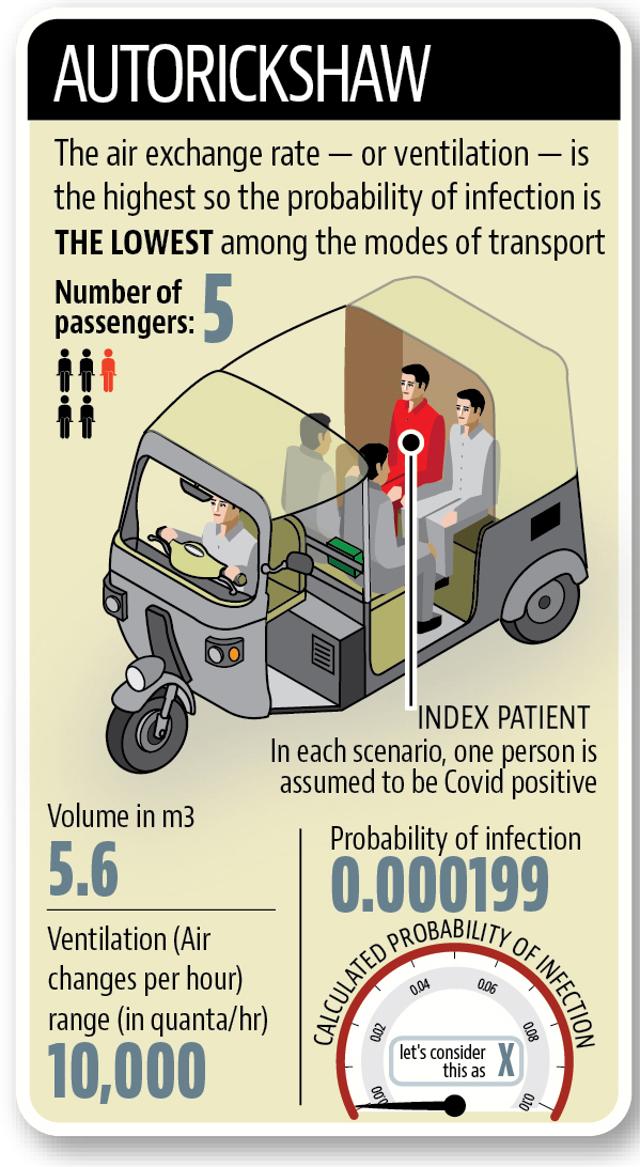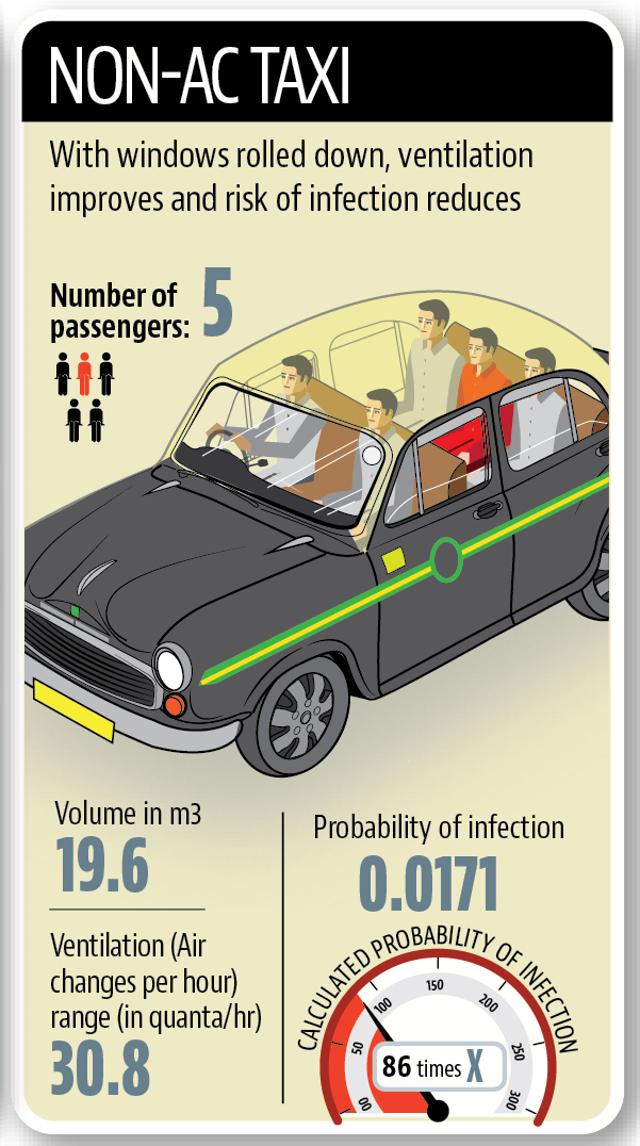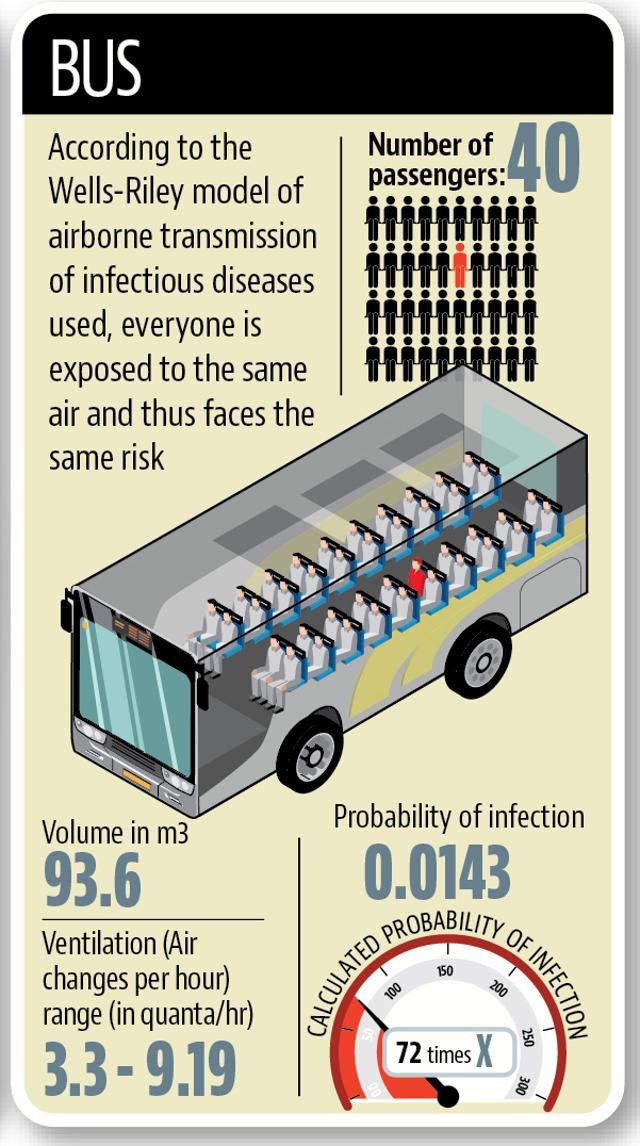A man or woman is pretty much 300 moments much more likely to contract the coronavirus illness (Covid-19) sitting in an air-conditioned (AC) taxi with a passenger, who is Covid positive, than she is sitting down in an autorickshaw, a current research by two experts at the Johns Hopkins College (JHU), Bloomberg College of General public Health and fitness, Division of Environmental Overall health and Engineering, found.
The probability of catching the infection is decreased by 250{c9ada2945935efae6c394ba146a2811ce1f3bfd992f6399f3fbbb16c76505588} in a taxi with the windows rolled down (non-AC) in contrast to a person exactly where the air conditioning is on. The scientists calculated that the chance in the two varieties of taxis was minimized by 75{c9ada2945935efae6c394ba146a2811ce1f3bfd992f6399f3fbbb16c76505588} when the cars sped up from zero to 120km/hour.
The research titled “Risk evaluation of unique transportation automobiles in India in the course of COVID-19 pandemic” by Darpan Das and Gurumurthy Ramachandran was posted in the peer-reviewed journal, Environmental Exploration, on Could 11.

When Das is a postdoctoral fellow at JHU, Ramachandran is a professor in the environmental health and fitness and engineering section.
The scientists calculated the possibilities of contracting Covid-19 an infection in four autos widespread to Indian metropolises —AC taxi, non-AC taxi, bus and vehicle rickshaw— working with a range of ventilation rates (air exchanges per hour) taken from past studies and observed that autos had been the safest of the four solutions.

All eventualities accounted for the existence of a single index individual in the stationary motor vehicle and with everyone — five travellers in each individual of the autos apart from the bus, which seated 40 — wearing a mask (surgical or cloth).
In contrast to the car, the danger was 86 situations greater in a non-AC taxi and 300 situations much more in an AC taxi (probability of infection: .000199, .0171, .061 respectively). A individual was 72 instances much more probably to deal Covid-19 in a non-transferring bus with its home windows open and seating 40 folks (chance of an infection: .0143), compared to an vehicle surrounded by 4 other folks, including the index individual.
The researchers employed the Wells-Riley model of airborne transmission of infectious ailments, which has been previously employed for knowledge transmission of tuberculosis and measles. This product, made use of to compute the outcome of air flow on transmission, assumes that the air includes doses of the infectious virus, and the air is well-blended. The design predicts that the focus of doses of infectious virus will tend to be significant in compact, poorly ventilated rooms, and it would be lessen in larger sized, far better ventilated rooms.
“As an input to the product, we have thought of unique viral emission fees from the contaminated person—two to134 quanta/hr (amounts of airborne virus for every hour) dependent on diverse functions these types of as singing, conversing etcetera. Mainly because of the modest volume of the motor vehicles, it was assumed as a well-mixed home,” Das described.
In the car, five people (together with the driver) sit beside each individual other in greater proximity, but on account of ventilation – the price at which the air quantity adjustments, or air exchange price – the likelihood of infection is the minimum. In a bus, with 40 people today seated, the chance of infection is better on account of lesser air flow. In the model utilized by the scientists, irrespective of in which the traveller sits, anyone is exposed to the exact same air and as a result, the identical risk variable within the auto (when it is stationary and shifting).

In their study, Das and Ramachandran assume that infectious aerosols are evenly distributed in the course of the vehicle’s interior volume of air, and are eradicated by ventilation, auto air filtration, gravitational deposition, and viral inactivation. The likelihood of infection is relevant to the number of airborne viruses inhaled.
“Due to the airborne nature of the virus, aside from 6 ft length and masks, ventilation is also an crucial parameter to limit the transmission of SARS-CoV-2,” Das claimed.
“This is not to say that automobile rickshaws are fully risk-free. We’re declaring that automobile rickshaws are comparatively safer, if you have a mask on,” he stated.
Employing a hazard estimator developed previous calendar year by US-dependent researchers studying a super-spreader party in the United States, Das and Ramachandran uncovered that when the car amplified its speed from zero to 120 km/hr, this led to a reduce in the probability of an infection by close to 75{c9ada2945935efae6c394ba146a2811ce1f3bfd992f6399f3fbbb16c76505588} in both of those the AC and non-AC taxis, and the chance of infection lowered to .0043 for non-AC taxis and .0153 for AC taxis.
The scientists, however, did not determine by how considerably the chance issue reduced if the bus is in movement but mentioned above an e mail interview that it was most likely to decrease. The paper also mentioned that the chance of danger is probable to keep on being the identical in an autorickshaw irrespective of whether it is stationary or in motion, for the reason that of its design.
The duo is now operating on estimating threat of passengers in rail and air journey. “The ongoing pandemic has introduced an option to reconsider and redesign air flow systems in community transit cars and also the position of mass transit to not only decrease danger of infection through this time, but also lower publicity to PM 2.5 and other air pollutants for the future in a sustainable way,” mentioned Das.
The scientists also calculated the chance of a traveller in these 4 transportation modes from exposure to particulate make a difference (PM) 2.5, which are very small particles of pollutants in the air that trigger respiratory health conditions and lousy visibility. They uncovered that the chance component was the opposite of that for Covid-19. The danger of publicity to pollutants was lowest for AC taxis, followed by non-AC taxis, buses and auto rickshaws.

“In a non-Covid-19 state of affairs, when publicity to PM 2.5 is bigger, it is ideal to travel in an AC taxi, compared to an automobile. But in a Covid-19 circumstance, which is considerably much more harmful, automobile rickshaws are preferable,” mentioned Das.
Das stated: “These are two competing challenges. In circumstance of Covid-19, the danger boosts with a established of actions these kinds of as closing windows and cutting down circulation but in scenario of publicity to PM 2.5, the possibility minimizes with these actions.”
“It is an intriguing examine, which is primarily based on modelling, specifically since we program to open up the lockdown slowly in the foreseeable future. We already know that air flow can cut down the unfold of the virus. From a regulatory position, we can check with men and women to roll down their windows though travelling in public transport. Of class, this will become tricky in monsoon,” said city-centered pulmonologist Lancelot Pinto, who was not involved with the analyze.
“Now that we are working with hypothesis that the virus is airborne, there is a prospect that a preceding passenger leaves a trail of virus in the taxi,” explained Pinto incorporating that the analyze pointed to the point that masking up, preferably in an N95 mask, remained crucial to any mode of public transport.



More Stories
Navigating the Labyrinth: Unveiling the Dynamics of Car Insurance in Malaysia
Buy PS3 Games – Things You Should Know While Buying PS3 Games
What Should A Product Manager Do When The Wrong Customer Buys Your Product?